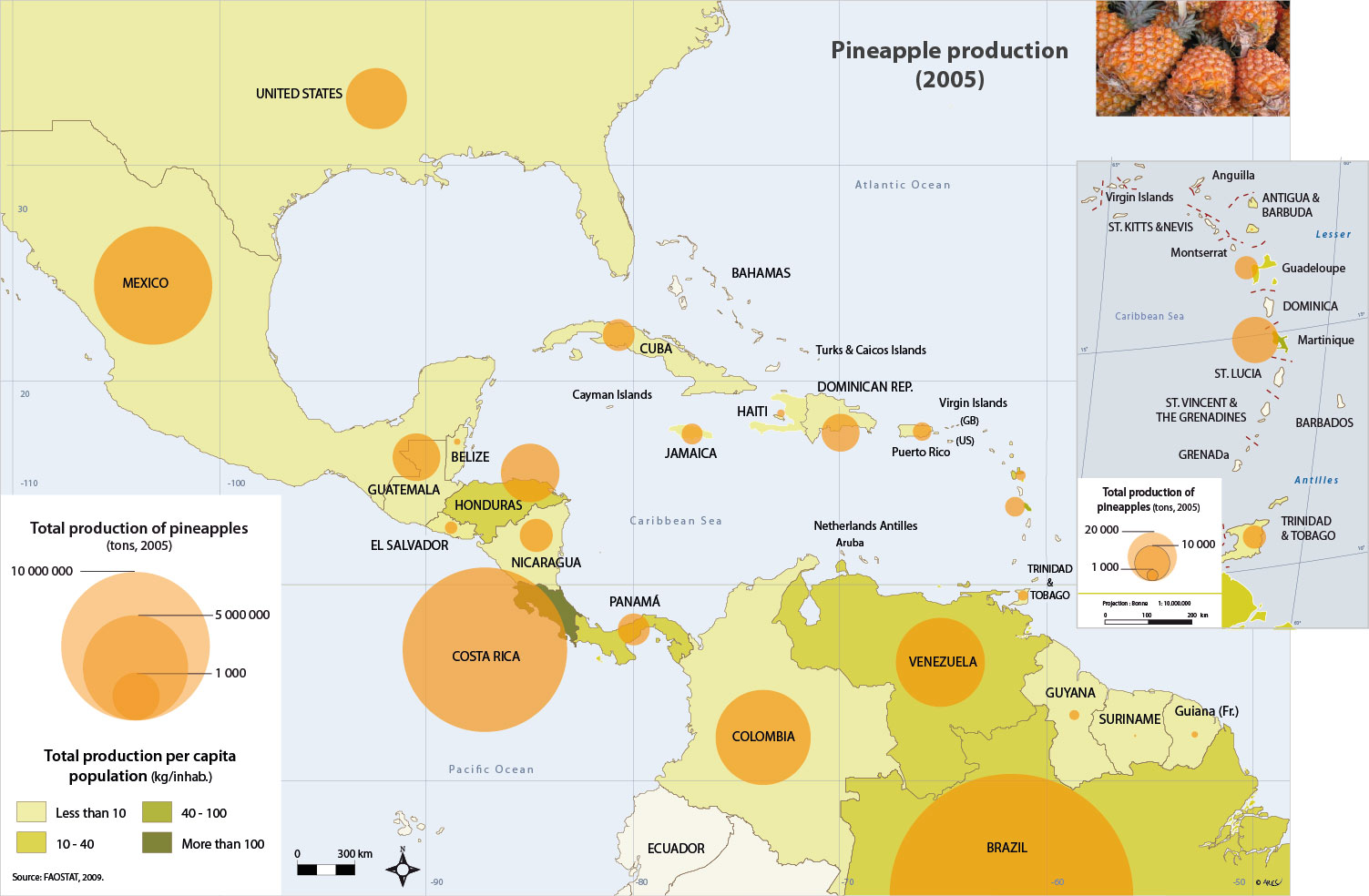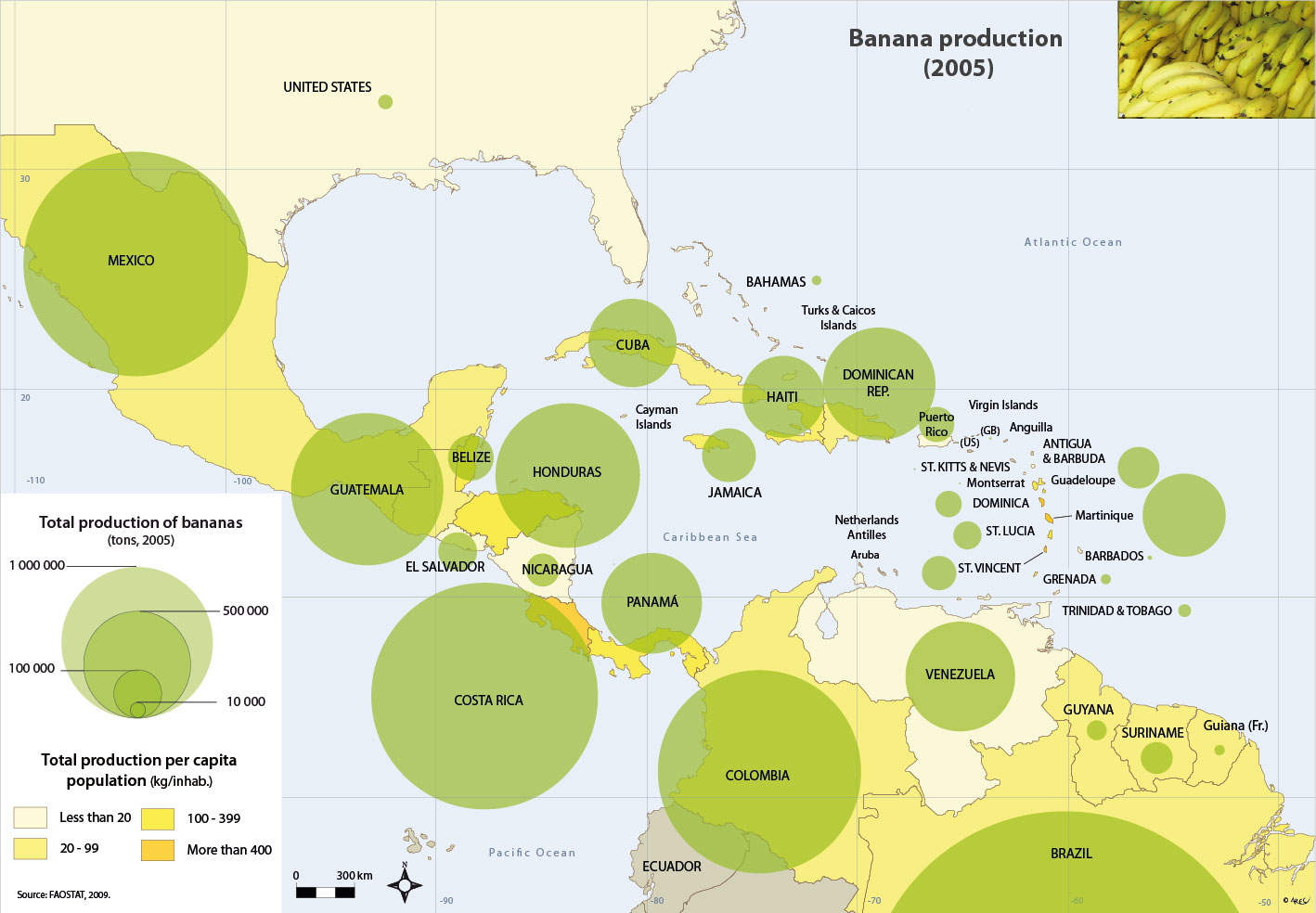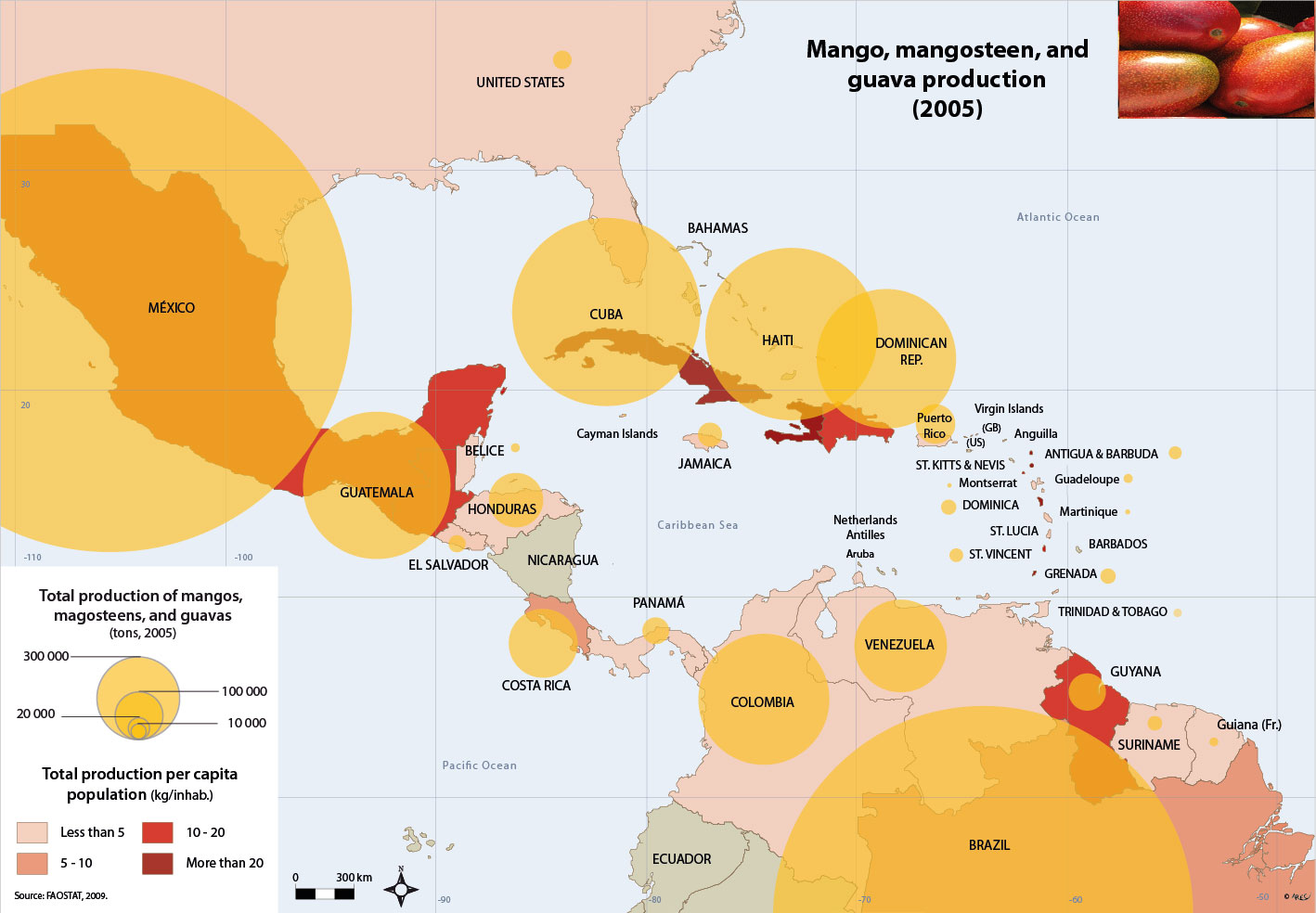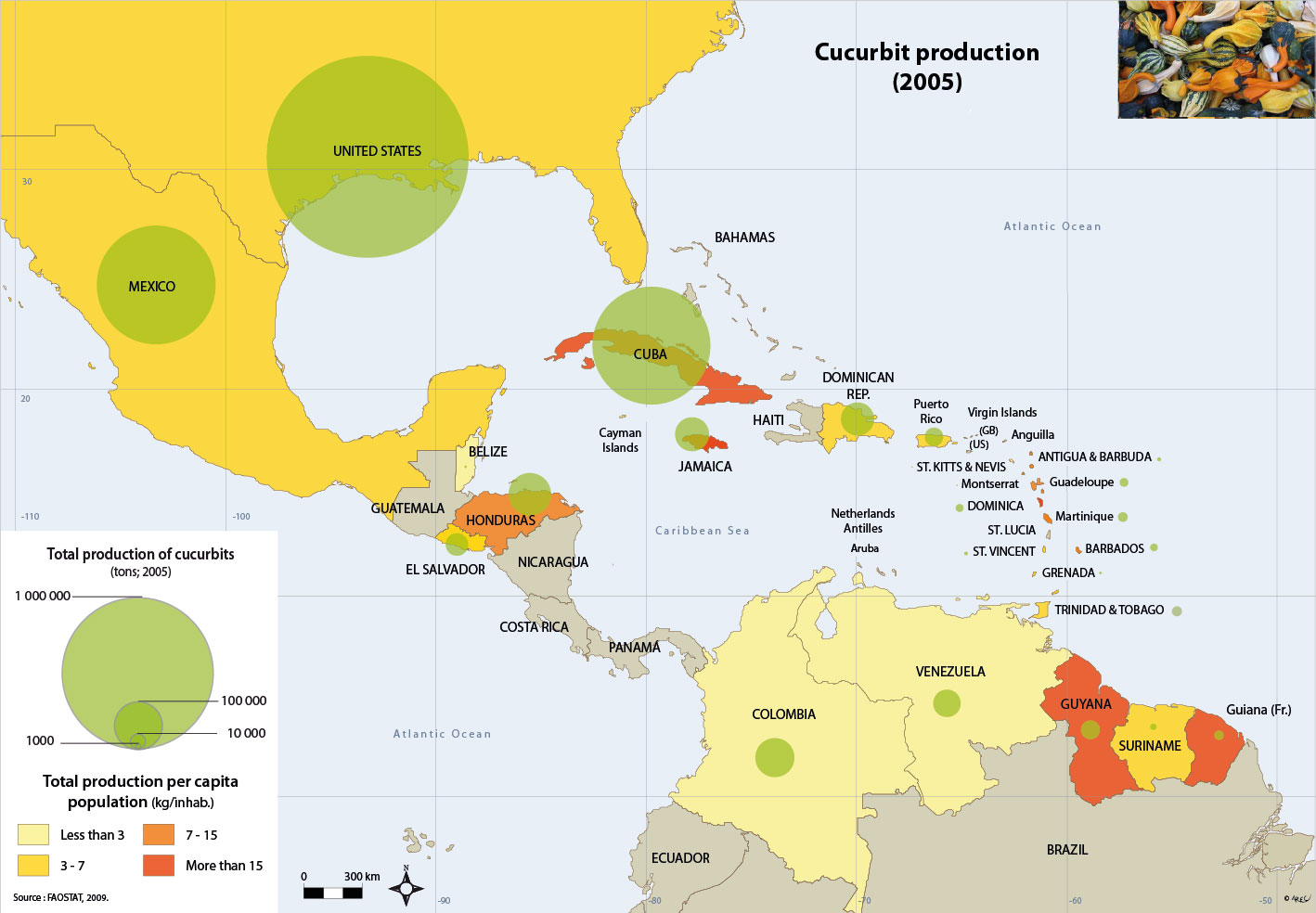
- Agriculture (2006-2009)
- Agriculture : mutation (2005-2006) FR ES
- Agriculture: emblematic landscapes
- Agriculture: food-self sufficiency (2005-2007)
- Agriculture: production (2007-2008)
- Commerce extérieur (2001) FR
- Currencies
- Economic organisations (2009)
- Fishing (1995)
- GNP per capita (1995)
- Integrated energy strategy (2004-2007)
- La Chine dans la Caraïbe FR
- La pêche dans le bassin Caraïbe - 2019 FR
- Le bassin caribéen, théâtre affirmé d'une guerre d'influence sino-étasunienne ? FR
- Nouveau contexte pétrolier (2015) FR
- Nouvelles donnes régionales (2004-2006) FR
- Sugar and Oil (1999-2011)
- Tax havens (2007-2010)
- Tax havens (2008-2012)
Understanding the realities of agricultural production in the Caribbean in relation to the region's local populations must take into consideration not only overall totals for this product or that state, but much more the same figures set against the population totals of the country in question.
Clearly, it appears paradoxical to want to compare countries as diverse as Mexico, whose land area is around 1.98 million km2 and a population of 110 million with Dominica, a tiny island of 754 km2 and less than 50 000 inhabitants.
In spite of all the technical innovations and policies, whether optional or not, production totals alone can never be comparable. Even production per capita does not reveal everything, but at least gets closer to the notion of self-sufficiency, particularly in small countries, thereby allowing some assessment of the options chosen by their populations in an increasingly globalised market.
1. Often, physical environment explains agricultural choice
The Dominican example with its mountainous topography illustrates this whole problem of adapting large-scale farming to natural conditions. For a long time, relief proved an obstacle to large-scale production for export, such as sugar cane or banana cultivation. Today this same handicap has instead become an advantage for vegetable production (root crops, tubers, green vegetables...), or again for fruit growing for which the production totals attained appear surprising. Accordingly, Dominica produces annually 348 kg per capita of citrus fruit, whilst Martinique where the natural environment, particularly in the north of the island, is similar, has difficulty attaining a per capita total of 3.5 kg.
Conversely Barbados, a small island with lower altitudes and less precipitation, has been able thanks to a considerable and innovatory research effort to expand its sugar cane production (1 454 kg per inhabitant). Per capita production was also very high in St. Kitts and Nevis, but the low returns in 2007 obliged the government to close the last remaining large sugar refining plants.
2. History still remains an explanatory factor in directions taken in agricultural production by different countries
The Greater Antilles, Central America and the northern part of South America over the last three centuries have seen the development of large-scale stock rearing on the great haciendas. For 150 years, pirates across the archipelago lived off hunted animals originally introduced by Europeans, thence returning to the wild (oxen, horses, pigs). Until recently, this stock rearing tradition was maintained and explains the sizeable production of milk and meat in the countries of the isthmus and South America (over 100 kg per inhabitant per annum, even up to 235 kg in Honduras or the tiny island of Montserrat, which seems surprising). It is here that tradition prevails.
3. Recent choices in agricultural policies can modify the overall picture of agricultural production
During the 20th century, banana production emerged as a possible substitute following repeated crises facing the sugar cane industry in the Lesser Antilles. But very quickly this fragile crop, subject to the hazards of weather, particularly cyclones, was exposed to competition from the big mainland producers. Differences between producers vary seven-fold, with Dominica producing seven times less than Costa Rica, the latter clearly not part of an even playing field.
It is left to the smaller producers to find particular niches. These can thereby achieve a quasi self-sufficiency in foodstuffs, by increasing the output of fruit and vegetables, adding value to their production whilst striving to organise a regional market which plays on proximity.
Setting aside the difficulties of achieving Caribbean integration, the fact that all the countries produced the same commodities was for a long time glossed over. With regard to the agricultural production of each island, it is no longer totally the case. For vegetables, fruits, root crops and tubers, part of the needs of Martinique and Guadeloupe could be sourced from the other islands of the Lesser Antilles as in the case of citrus fruits, or even from the mainland. Avocados and pineapples would thus have less than half the distance to travel.
Taking stock of the production realities and potentials of each country suggests that a fairly optimistic scenario exists for the organisation of a regional market at the scale of the Greater Caribbean. The present economic climate, the environmental challenges linked to global warming, the rising costs of energy and raw materials in years to come, all push towards finding regional solutions. A clearer picture of the region's agricultural capacity can help these markets to emerge. Fragmentation, three centuries of history, are presently acting as a brake on achieving progress, but a real Caribbean awakening can also change the way the cards are stacked.
The Caribbean region produces nearly 41.8 million tons of citrus fruit, representing one third of the world total (36.2%). Brazil occupies top position within the zone, alone producing half the total production (20.6 million tons in 2007). In fact, most of the production is accounted for by just 3 countries – Brazil, Mexico and the USA. But if set against the total population of each producing country in the region, Brazil falls back to third place amongst the 31 states in question. As for Mexico and the USA, the results remain above the regional average. The largest producer as measured on a per capita basis is Belize with a spectacular total of more than 936 kg per inhabitant. Citrus fruits remain the principal fruit of the Caribbean.
One pineapple in 3 eaten each day across the world comes from the Caribbean. The countries of this region produce more than 6 million tons of pineapples, of which one third comes from Brazil (2.6 million tons). Most of the region's production comes from the isthmus states and the northern part of South America, together totalling 5.5 million tons. Equally, it is across this zone that the countries show the highest per capita production, headed by Costa Rica with nearly 292 kg per inhabitant, and with the USA at the other end of scale, producing less than 0.6 kg per inhabitant representing a total of 172 500 tons in 2007. Note that Martinique and Guadeloupe fall within the main group with the highest per capita production, respectively 45 kg and 11.8 kg per inhabitant.

The leading producer of bananas per capita in the Caribbean is incontestably Martinique with more than 751 kg per inhabitant, well in front of the USA which produced only 0.03 kg per inhabitant in the same year. With some 200 kg less per capita, Costa Rica is in second position. In total, the Caribbean represents 22.4% of world banana production, around 18.2 million tons. Add to the latter, some 6.2 million tons of plantain bananas, and the total contribution to world markets directly originating from the Caribbean rises to 24.5 million tons. The plantain banana is a particular characteristic of the region, with an average per capita production of 30.5 kg, with Belize heading the list (136 kg per inhabitant). It is noteworthy that the isthmus states with their high tonnages, also produce amongst the highest yields in the world (40 kg per hectare in Costa Rica or Guatemala, only 10 kg per hectare in the Philippines and the Greater Antilles, whilst generally not more than 7-8 kg per hectare in the remaining producer countries).
One avocado out of every two produced in the Caribbean comes from Mexico, the foremost producer in the region with more than 1.1 million tons annually. Caribbean production serves more than 61% of the world market. On average, 3.5 kg of avocados are produced annually for each of the region's inhabitants. With regard to this ratio, Grenada stands out with nearly 17.7 kg as against 10 kg for Mexico (whilst noting that the latter country is the region's top producer by total volume).
In the popular imagination, the production of tropical fruit is generally associated in particular with the Caribbean. However, only 14.5% of world production comes from this region. 4.8 million tons originate from Caribbean farms out of a world total of 33.4 million tons. In the region, only 9 kg per inhabitant are produced on average. This low figure should not be allowed to mask very high regional differences, with Haiti totalling more than 29 kg per inhabitant and the United States only 0.01 kg.
Amongst agricultural produce than can at best be characterised as secondary in the region, cucumbers total only 3.4 million tons and represent just 5.1% of world production. However, the latter provides a large proportion of the region's local needs. Cucumbers, pumpkins (known locally as ‘giraumons') are part of the local food heritage (traditional regional fare), often served with a fish course. Again, the bald figure conceals diverse local situations in which Cuba leads with 53.2 kg per inhabitant in 2007. On average, cucumber production accounts annually for less than 10 kg per inhabitant.
top
|
  |


















